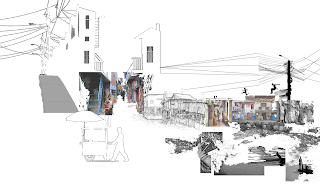A conversation with BA (Hons) Interior Design graduate, Chaity Barua
A conversation with Chaity Barua
This month, I spoke with BA (Hons) Interior Spatial Design graduate from Chelsea College of Art, Chaity Barua, about her work and transcultural experiences. I included Chaity in the Team LEWIS Foundation annual exhibition with recent graduates from 2020-2021. We talk about building a professional practice after graduating from a university design programme, and the significance of problem-solving design ideas.
JY: Tell me about yourself.
CB: I was born in Bangladesh, but grown up in Italy. As a designer, I try my best to illustrate and cope with theme projects that are able to manifest or even illustrate today's endless difference between culture, gender, religion, and social class system etc. Therefore my knowledge and curiosities regarding different cultural values, the way I see and approach my work is strongly affected by it. Specifically, the different social interaction systems present in India.
JY: What is your practice (and/or the work you do now)?
CB: I am now working as a freelancer. I try to cope with design ideas that can be related more to a contemporary social justice system, themes such as (rich/poor, equality). I think, is really important to design ideas that can bring change to today's society, the way we think and interact. I use my drawings as a "conversation" to connect with others in order to bring any change to society, even small.
JY: How you make/do your work (job or practice)?
CB: I do my work through a research process, always on the hunt for thematics that are unique and strong on their own. Followed by analysis and questions regarding the thematic which will then allow me to respond and illustrate the issues regarding a certain subject.
JY: What do you do when you're not working (hobbies or interests)?
CB: Photography and painting is my hobby. Even though I want to start a course in playing the piano. I like to take photos of the daily lifestyle of people in the city as well as portraits. It allows me to get inspired.
JY: What inspires you (in different ways: creative, positive, negative, or genal ways)?
CB: To be honest, what inspires me are the issues regarding any subject matter. If there is a problem regarding a theme that means that a certain subject needs problem-solving design ideas. Problems allow designs to reflect in a boundless way.
JY: What problems do you face as a maker/recent graduate? What problems in your practice/work/or related hobby?
CB: I guess, the issue is not being able to get as many opportunities to showcase our abilities as graduates. And given the whole pandemic situation, it certainly makes things more complicated, not being able to explore as much as the time before the pandemic, social interaction, connectivity with other artists/designers etc...
JY: How do you address these problems?
CB: The reason behind,I try to engage with other artists/designers through my social media. I share my work and ideas by posting in social, hoping it might bring any change to someone or something.
JY: What works (art or in another field) by others do you find important or significant?
CB: I think music works kind of hand in hand with art. The power of both music and art in sending a message is unimaginable.
To end our conversation, I turn to Chaity's designs. As a practising designer, Chaity Barua shared her recent work, which I included in this year's Team LEWIS Foundation annual exhibition of recent graduates' work at Millbank Tower. Below Chaity shared more details about her work.
About the Work
@chaityin.design
https://graduateshowcase.arts.ac.uk/projects/4180/common-ground-chaity-barua/pages/1
Check out the Team LEWIS Foundation webpage for more details about the annual exhibition.






Comments
Post a Comment